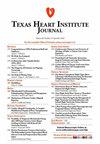Successful Percutaneous Thoracic Duct Embolization for Chylothorax After Total Arch Replacement.
IF 0.9
4区 医学
引用次数: 0
Abstract
Chylothorax after cardiac surgery is a rare complication associated with severe morbidity and mortality. This report documents successful treatment with percutaneous thoracic duct embolization for chylothorax after total arch replacement. A 69-year-old man underwent replacement of the aortic arch to treat a ruptured aortic aneurysm. After surgery, the left thoracic drain discharged 2,000 to 3,000 mL serosanguineous fluid per day, even though the patient took nothing orally and was administered subcutaneous octreotide therapy. On postoperative day 9, percutaneous thoracic duct embolization was performed, and the drain could be removed. The chylothorax did not recur, and the patient was discharged on postoperative day 17.经皮胸导管栓塞治疗全弓置换术后乳糜胸获得成功。
心脏手术后的乳糜胸是一种罕见的并发症,具有严重的发病率和死亡率。本报告记录了经皮胸导管栓塞治疗全弓置换术后乳糜胸的成功案例。一名 69 岁的男性接受了主动脉弓置换术,以治疗破裂的主动脉瘤。术后,左胸腔引流管每天排出 2,000 至 3,000 毫升血清脓液,尽管患者没有口服任何药物,也没有接受皮下注射奥曲肽治疗。术后第 9 天,进行了经皮胸导管栓塞术,引流管得以拔出。乳糜胸没有复发,患者于术后第17天出院。
本文章由计算机程序翻译,如有差异,请以英文原文为准。
求助全文
约1分钟内获得全文
求助全文
来源期刊

Texas Heart Institute Journal
CARDIAC & CARDIOVASCULAR SYSTEMS-
自引率
11.10%
发文量
131
期刊介绍:
For more than 45 years, the Texas Heart Institute Journal has been published by the Texas Heart Institute as part of its medical education program. Our bimonthly peer-reviewed journal enjoys a global audience of physicians, scientists, and healthcare professionals who are contributing to the prevention, diagnosis, and treatment of cardiovascular disease.
The Journal was printed under the name of Cardiovascular Diseases from 1974 through 1981 (ISSN 0093-3546). The name was changed to Texas Heart Institute Journal in 1982 and was printed through 2013 (ISSN 0730-2347). In 2014, the Journal moved to online-only publication. It is indexed by Index Medicus/MEDLINE and by other indexing and abstracting services worldwide. Our full archive is available at PubMed Central.
The Journal invites authors to submit these article types for review:
-Clinical Investigations-
Laboratory Investigations-
Reviews-
Techniques-
Coronary Anomalies-
History of Medicine-
Case Reports/Case Series (Submission Fee: $70.00 USD)-
Images in Cardiovascular Medicine (Submission Fee: $35.00 USD)-
Guest Editorials-
Peabody’s Corner-
Letters to the Editor
 求助内容:
求助内容: 应助结果提醒方式:
应助结果提醒方式:


